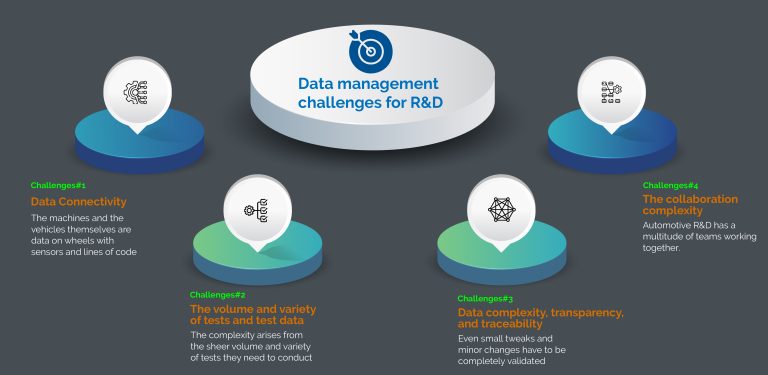Data Management Challenges of R & D Teams in Automotive Companies:
The automotive industry across the globe is facing cost and rationalization pressure. Price pressures are now shaping the market and it is harder to create competitive differentiation. Owing to this, automotive manufacturers are seeking new market opportunities and looking for avenues to create a competitive advantage.
The customers’ demands for product quality and new technology features are only increasing. Automobile companies have to build sustainable, safe, and secure products and services. These services and products have to also be affordable within a global market while considering environmental and safety considerations. All such factors require automotive companies to do extensive product testing, leading to the creation of a massive amount of data.
Most of these challenges and the need for greater responsiveness can be handled using a holistic data structure. However, to gain a data advantage, developing strong data management capabilities is crucial.
Data management challenges for R&D
The scale of data that is available in the automotive industry can appear to be intimidating. As the automotive industry gets transformed by technologies, R&D teams have to develop the capability to harness, store, analyze and play with the different types and vast volumes of data.
It is important to first understand the data management challenge of the R & D teams.

Challenge 1: Data connectivity
Automotive R&D is asset-heavy.
- The machines and the vehicles themselves are data on wheels with sensors and lines of code
- The data has to be collected across systems, sensors, and connected devices
- A vast number of data points have to be transferred for proper storage and analysis
- Along with this, there is the test data that needs to be managed. With the growing proliferation of digital twins, testing has moved to the virtual world. These digital assets have to be connected to the right digital processes. This can become a challenge owing to the wide number of teams and tests at work
- The variety of data also keeps changing. Heterogeneous data and different data formats are a commonplace
- Engineering high volume data is more complex with high volume and attributes, and multiple parameters. It is difficult to integrate such data for analytics and gain the right insights to fuel decisions
Challenge 2: The volume and variety of tests and test data
R&D teams in the automobile industry have to conduct a huge multitude of tests. For successful production, R&D teams have to start analyzing and testing in the pre-production phase, the design phase, and also in the post-production phase.
- The complexity arises from the sheer volume and variety of tests they need to conduct
- All the test data must also be seen from a single lens to gain a comprehensive and clear understanding
- Many times, companies employ a variety of testing tools for clear data analysis. However, these testing tools operate in silos and thereby add complexity to R&D decision-making. The numbers from all of these tests are co-dependent and cannot be looked at in isolation. Often this information has to be collected and analyzed manually making the process complex, effort-intensive, and time-consuming. It also opens up error pathways that can impact the quality of outcomes
- The rise of digital twins for testing further adds to testing and data management complexity. The test assets are expensive and have to be maintained well
Challenge 3: Data complexity, transparency, and traceability
The R&D testing scenarios are endless. The design phase has to be validated. Tests on engine performance, fuel consumption, vibration or noise measurements, and endurance tests are only the tip of the testing iceberg.
- Even small tweaks and minor changes have to be completely validated
- These tests and the test data have to be centrally stored to drive collaboration. However, most of the data is generated across the different domains and in different formats. It needs to be homogenized to make it usable
- In the absence of a centralized data repository, R&D teams have to do a lot of heavy lifting to gather a comprehensive understanding of the data in siloed systems to drive intelligent decisions. These results can also be hard to retrieve after a few years.
This leads to R&D teams spending an inordinate amount of time and effort in conducting the same tests repeatedly for vehicle validation. They also incur more costs to do the same.
Challenge 4: The collaboration complexity
Automotive R&D has a multitude of teams working together. There can be no mismatch between design and function. There has to also be extremely high levels of collaboration amongst and across all teams.
- It is a challenge to automatically store and analyze large volumes of engineering data systematically and efficiently if the data platform is not optimized to support distributed and parallel computing
- The data has to be easily imported and allow the engineer to work on it without worrying about data preparation, different data formats, or data locations to drive automatic analyses
- The engineers should also be able to manage and schedule jobs easily
The Solution – A data management platform for automotive
While big data systems like Hadoop have been in use by R&D teams, such big data systems cannot effectively process binary data processing. Automotive R&D teams need big data platforms that can help them manage structured engineering high-volume binary data.
Given the complexity of data and operations in the R&D ecosystem, automotive organizations have to enable their teams with a comprehensive platform that meets the need of this domain. R&D teams need a platform that is specifically designed for engineering data and provides multiple language support (languages such as MATLAB, Python & JAVA) for analysis processing.
Such a platform should:
- Operate as a distributed storage and processing platform to accelerate processing time
- Standardize engineering test and validation data with a common identifier to enable R&D teams to create a centralized data information repository
- Enable Graph DB support at the enterprise level to store metadata, schema-free nature of neo4j, and store data and its relations dynamically
- Provide job scheduler support and make it easy for R&D teams to schedule jobs, at specific times or events like test import, test order change, etc. and execute them
- Allow teams to keep track of job executions and their details for ready reference and eliminate the need to run a job each time an import takes place in a test
- Centralize logs, and track log files of their connected applications
- Allow R&D teams to easily deploy and manage the cluster application services in a single click and manage the entire suite of connected applications within the cluster
- Create a central information repository with all the test data and test method standards, provide complete visibility into the status of all assets to the teams, and drive collaboration between design, development, and testing teams.
- Deliver a high-performance parallel computing architecture coupled with a well-defined semantics meta-model for domain know-how for easier engineering product validation
In Conclusion:
Automotive companies are looking to drive competitiveness, eliminate waste, drive sustainability, reduce costs, and optimize the product validation phase. Data-backed decisions become crucial to achieving these while navigating customer demands, meeting compliance needs, and accelerating time to market.
A scalable data platform with the knowledge of complex engineering data in the automotive domain can address specific data management challenges of this industry.
Distributed Brix, or DBrix, is a platform created specifically to help automotive R&D teams navigate their data management challenges easily. The platform has been built leveraging two decades of domain experience and a deep understanding of the complexity of engineering data in the automotive domain.
Connect with our experts to see how to create a centralized data repository to improve and accelerate R&D outcomes.



